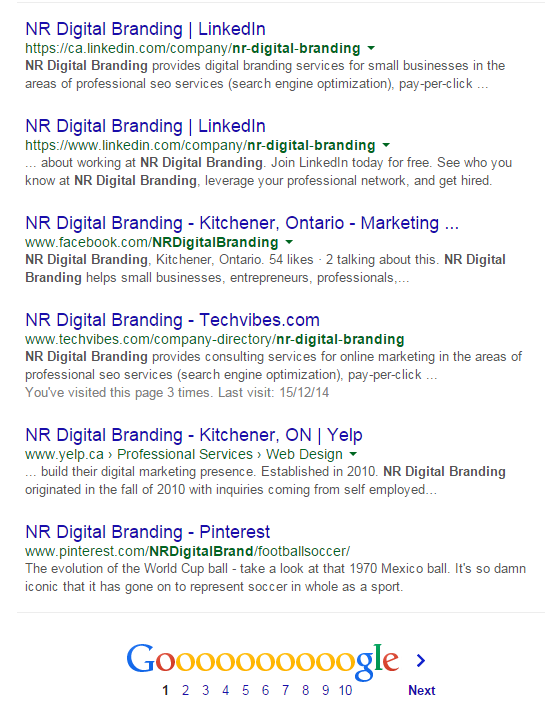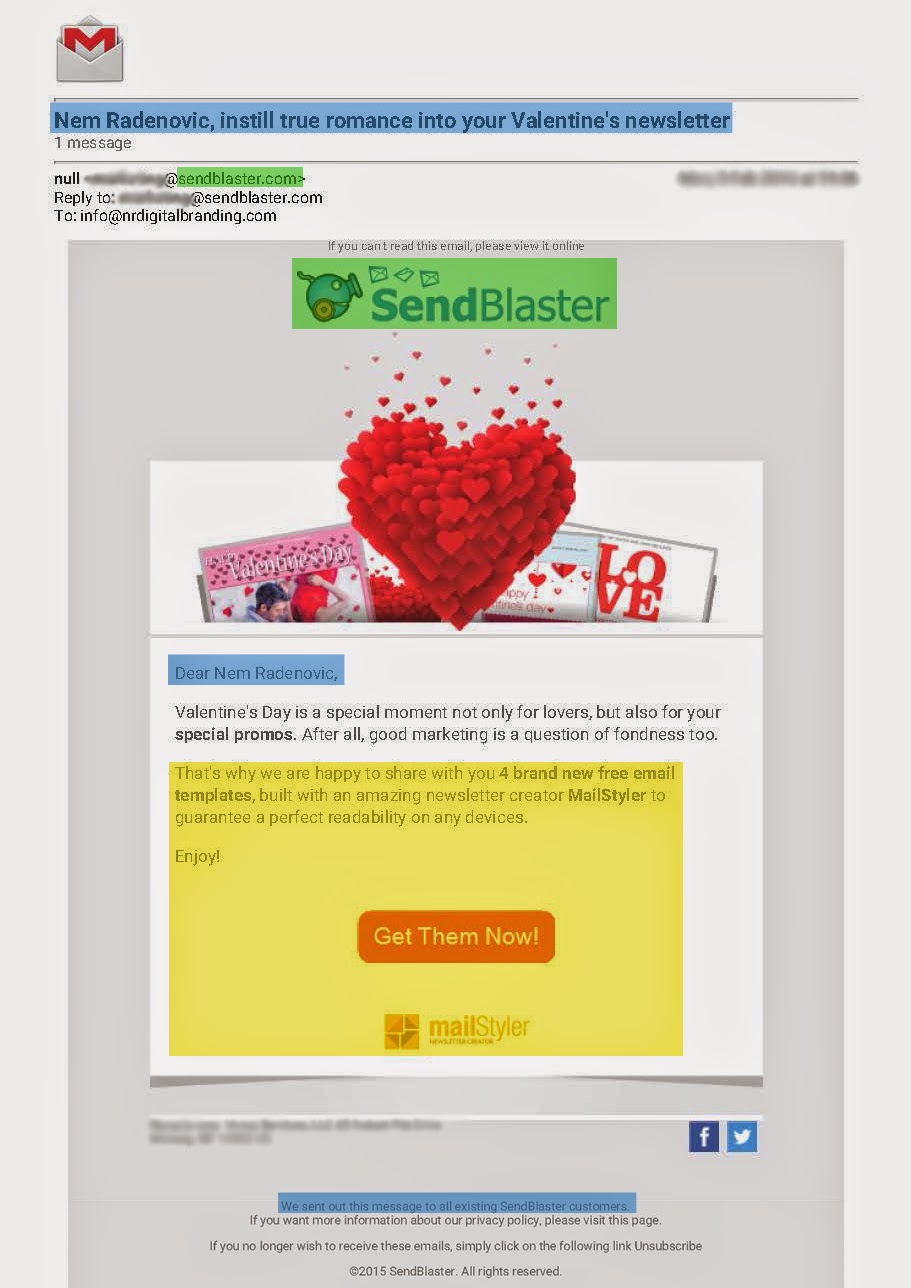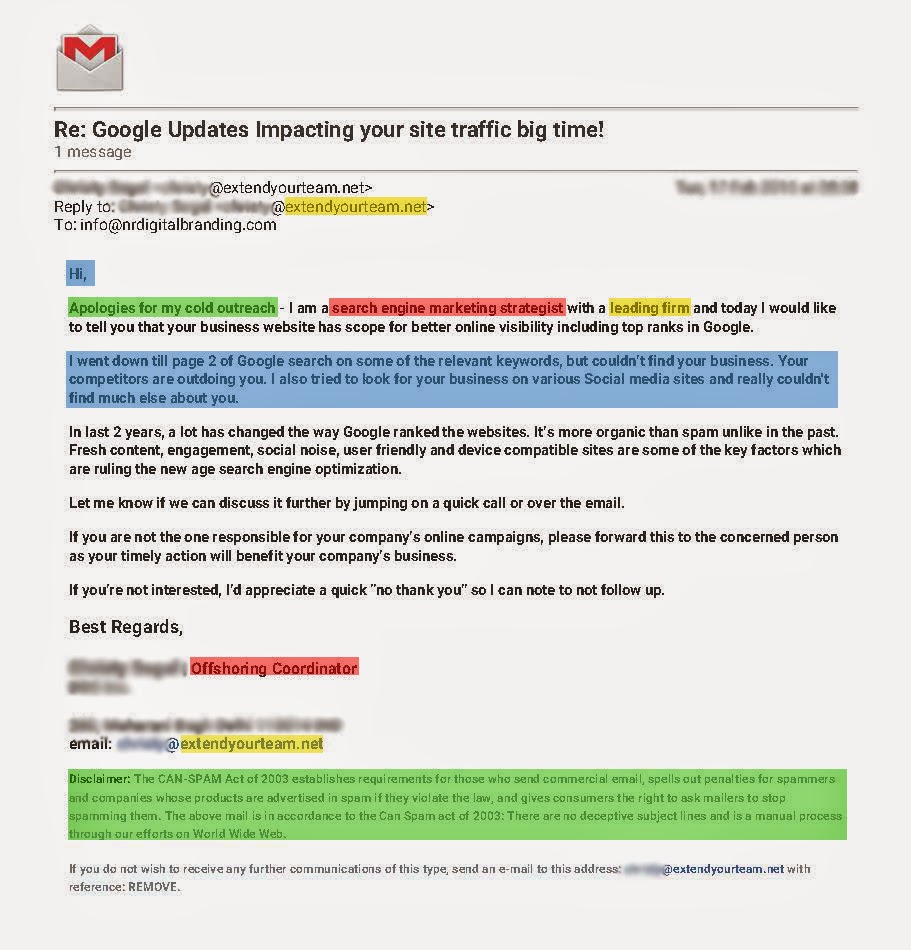If you have a website or a social media presence with any sort of contact information (especially a publicly published email) you have, or still do, probably received some sort of email marketing indicating that your website rankings are below the first page of Google. Similarly, the same proposal indicates how the sender can work special online marketing magic at an affordable rate – getting your company visible across social media, Google search, etc. Most of these emails are spam, and spotting real vs. spam is sometimes difficult.
However, there are ways to spot a worth-while email proposal from it’s spammy counterpart. Below we take a look at each type of email and it’s features that help set them apart:
Spam Email Proposal
Alright, lets start with each of the highlighted sections above:
No Visible Web Presence & Unsupported Self Boasting
The email indicates that this is a “leading firm” in online marketing – which is a fairly bold claim considering I have yet to hear or read anything about “extendyourteam.net” being mentioned within the digital marketing community world wide. Speaking of which, after attempting to open that URL I was unable to load any type of website – meaning that although this email preaches following best-practices and claiming to be a leading firm; it does not have a website of it’s own.
How are people supposed to see more information? Perhaps examples of previous work? Other than the information provided in the email, there is no trace of this company on the web. Usually a sign of spam.
Unsupported False Claims Used as a Bait Tactic
If you look at the introduction it simply says “hi” – it is not personalized directly to either the business name or addressed specifically to me as the recipient (keep in mind my name and contact information are accessible across my website, blog and multiple social media websites).
Similarly the paragraph highlighted in blue indicates that my website is not ranked on the first page of Google search results and that the business is no where to be found on social media. There are a number of factors to consider here:
What keywords is the website not ranked on the first page for?
If someone is searching: “digital marketing agency” of course none of the web pages will appear on the first page because that is not the keyword or key-term that is the focus of any of them. Lack of details and vague terminology give this part away.
Who are the competitors “outdoing” me?
Not a single competitor name or detail is included in there – if this was true they would point out that for search term A, competitor A is on the first page while my web pages are not. Is this mentioned anywhere in the email? Absolutely not – simply used as a persuasion attempt to take action.
Which social media websites did you look for, and what were you looking for?
Interestingly enough if I type my business name not only into the different social media platform search options, but in a general Google search, all of my social media profiles come up. More false claims:

Indicating Spam Intent & Highlighting Outdated Spam Laws
The first sentence of the email indicates that this is a “cold outreach” attempt, in other words spam!It only uses an apology to seem genuine so that the recipient would continue to read further.
Additionally, the inclusion of CAN-Spam Act of 2003 fine print after the signature is another sneaky way of masking legitimacy. Unfortunately most people will get confused by this trick as it gives the perception of following guidelines set out by the Canadian government. The Can-Spam Act of 2003 is no longer valid, it has been replaced by CASL (Canadian Anti-Spam Legislation) in 2014 and has been in full effect since last year!
Inconsistent Details
In the body of the email the person indicates their position as “search engine marketing strategist” while in the signature of the email the title of “offshoring coordinator” is used. If you come across discrepancies such as these it could very well be that your email was simply picked up online, put into a large list of recipients and mass blasted in an attempt to elicit some sort of response.
Luckily, companies providing actual services and following set guidelines are doing a much more appropriate job. Let’s take a look below.
Appropriate Email Proposal

Personal Communication & Reason Email Was Received
Unlike the example above, this legitimate email includes personal information in the subject line and as the first greeting message. What a difference it makes to hear an email sent to a person versus “I apologize for this cold outreach” copy & paste spiel.
In addition to the personal messaging, notice that at the bottom of the email further supports the reason as to why specifically the email was sent to me: I am an existing customer. And as an existing customer of an email marketing service, they are offering me free newsletter templates for Valentine’s Day. The message and the focus is spot on – everything aligns.
Plus, did you notice the easy unsubscribe option with no SPAM fine-print? Under the new Canadian Anti-Spam Legislation, that is the appropriate way to provide a communication termination option.
Credibility Through Online Presence & Branding
Send Blaster’s URL and logo are both easily searchable. If I go to their website I can clearly see that the logo in the email matches their website. The URL that the email came from works just fine and has further information on the company – giving it credibility as an email marketing solutions provider.
Clear Purpose & Indicated Action in Body of Email
The body of the email is kept short and to the point; it did not talk about how my email designs are bad (like the first email indicating that my website is suffering in SEO rankings), nor how I need to improve my email templates. Why? Because I do not send emails to Send Blaster – they do not know what my emails look like, all they do is provide the means for me to send emails. They are simply offering additional free resources on top of the one I subscribed to. Now that is providing customer value!
Although these emails do differ in some ways – there are a few similarities which make it hard to distinguish legitimacy of communication.
Similarities That Cause Confusion
1. Adherence to Spam Regulations
The spam email may seem as the more legitimate one due to its fine print of the CAN-SPAM regulations, but in reality this law has been replaced with a new legislation. It is important to point out that emails DO NOT require any fine print of regulations – they need to indicate the following;
- who the sender is
- what software or service they are using to send the email (if not their own)
- a clear unsubscribe option directly in the email
While not part of marketing communication legislation, good email messages will also indicate why you are receiving the email much like Send Blaster in the example above (signed up for newsletter, existing customer, etc.).
2. Credibility via Email Signatures or Branding
Notice that the first email seems perhaps a little more credible because the signature contains an “actual name”? While in most cases true, it is not always a good indication of legitimacy. Send Blaster may not have an actual person’s signature but it does have other aspects which make it credible: reason as to why the message was receive, clear cut privacy policy, refers to actual name of recipient in copy, etc.
Many spam emails will place “personas” or make-believe signatures to make them seem real. While we cannot for sure say if the person in the example above is real or not, it sure does not give me confidence knowing that they did not have matching titles (what they indicate in the opening paragraph of the email vs. their actual title in the signature) or any sort of web presence.
3. Personalization of Subject Lines to Encourage Open Rate
One email includes “Re:” as if it were replying to a previous email while the other has the recipient’s name. Which one is more legitimate? This would depend; I have never had previous communication with anyone from that first email. Therefore including the “Re:” is clearly a bait tactic to get me to open the message. The second email has my name, which is also a marketing tactic used to make the email look as if it was sent personally to me (not such a bad thing after all).
Hopefully this will help you distinguish between spam and regular marketing service proposals. We all known even the best filters will let through a few junk emails. The better you are prepared to recognize them in your inbox, the less time you will waste managing proposals.
Now I would love to hear any spam-like communication stories you may have come across from? Feel free to share below in the comment section to help others be more prepared.

